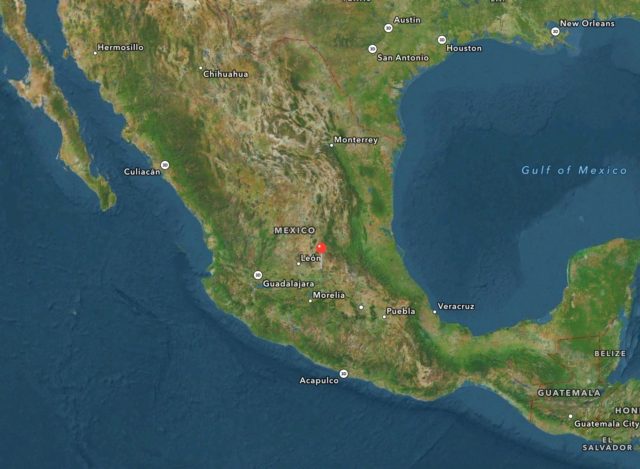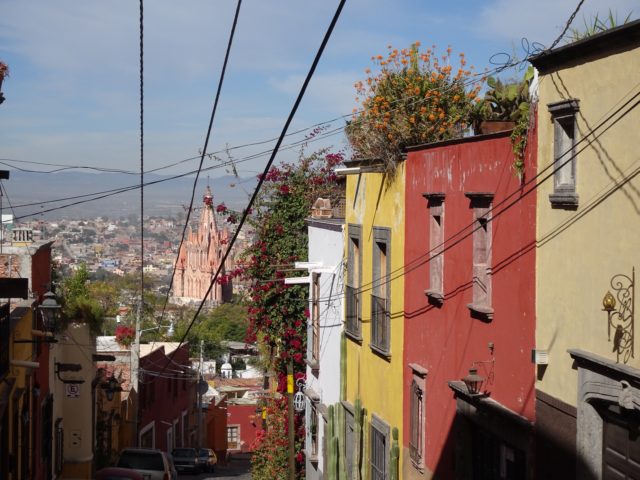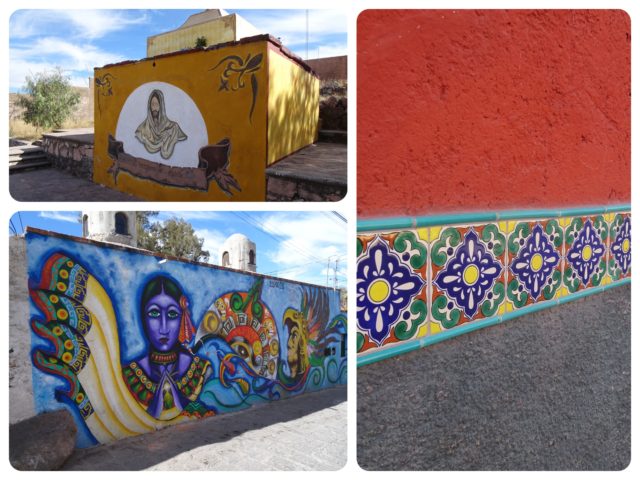San Miguel de Allende is a city located in central Mexico. 170 miles from Mexico City, SMA is located within Mexico’s hilly central highlands. The mild climate is temperate, described by some as “eternal spring.” January is one of the coolest and driest months. We experienced very pleasant days (low 70s) with cool evenings (mid-high 40s).


I am curious and wanted to learn a little more about San Miguel. It’s taken me a while to put together the key moments in history, and although this next section is relatively long, it is actually a very brief re-telling of San Miguel’s history. If you don’t care for history or bore easily, I suggest you skip this part and head farther down to photos of our first day.
San Miguel has had several names (I counted 5 in all) throughout its history. Before the arrival of the Spanish, conquistadores and priests, the native settlement was named Izcuinapan (place of dogs). In 1536 a Franciscan monk named Fray Juan de San Miguel led an expedition to explore the area and found a mission. Unfortunately, the existing building he chose did not last long so in 1542, the Fray Juan built a new chapel in San Miguel el Viejo (el viejo means “the old”), about a mile from today’s centro. The real history of San Miguel de Allende is usually dated from that event. Fray Juan dedicated the Spanish town to the Archangel Michael, christening it “San Miguel.” That also happened to be his own chosen name, so perhaps he had a dual purpose? 😉

From 1550-1590 the Chichimeca War raged between Spanish colonizers and their Indian allies against groups of the nomadic Chichimeca Indians. San Miguel was temporarily abandoned after an attack in 1550 which burned it to the ground and killed 15 people.
After establishing the mission, Fray Juan had left San Miguel in the hands of Fray Bernardo Cossín, while he set out to convert and/or save other souls. Fray Bernardo decided the location was too dry and too dangerous and led his people up the hill, to the site of the present day Chorro spring (chorro meaning “spring”). Here he began to rebuild the town, establishing it as both a mission and a military outpost. The new site was northwest of the old one at a place with two fresh water springs which supplied all of the town’s water until the middle of the 20th century.
By mid-16th Century, huge veins of silver were discovered at Zacatecas, and heavily loaded mule caravans were soon streaming south, carrying this river of silver to the capital, passing through San Miguel. The city was next known as San Miguel el Grande and sometimes San Miguel de los Chichimecas during this period.
San Miguel prospered for almost 300 years under the rule of Spain and the Catholic Church. The land was wonderful cattle country and supported large haciendas, the major road to Mexico City passed through San Miguel, and both Spaniards and indigenous peoples moved from the south to populate the rich land. The city lived up to its name as San Miguel el Grande. By the 1770s it was a wealthy, cosmopolitan city, larger than either New York City or Boston.

San Miguel el Grande played a prominent role in the Mexican War for Independence. In 1779 Ignacio José de Allende y Unzaga was born to a wealthy family in San Miguel el Grande . In 1810, he became an officer in the Spanish army, but soon became convinced of the need for Mexican independence. He joined the conspirators and other agitators for independence. On September 16, 1810, the Mexican War of Independence began. Allende led the rebels to several military victories and was named a hero, but he was captured by the Spanish and beheaded before the war was over.
In 1826, in honor of their heroic favorite son, San Miguel was renamed (again) as San Miguel de Allende, it’s fifth and final name.
By 1900, San Miguel de Allende was on the decline. With exceptional foresight, the Mexican Government declared San Miguel a National Historic Monument in 1926. This restricted development in the historic district and preserved the town’s colonial character.
Within the next 50 years, foreign artists moved to San Miguel and “discovered” its colonial architecture. The art and cultural institutes they founded gave the town a reputation that attracted other artists and then foreign art students, especially former U.S. soldiers studying on the G.I. Bill after the WWII. Since that time, San Miguel de Allende has attracted a significant amount of foreign retirees, artists, writers and tourists.
Today, an estimated 13,000 foreigners, mostly from the U.S. and Canada, call San Miguel home, making up about 10% of the population. They move here for the climate, the cosmopolitan yet quaint feeling, the art and culture, and…….. to escape high taxes and high cost of living in their homelands. I can testify from personal experience now that Mexico is much, much less expensive!
Back to us………… On our first morning, which began slowly, Kayda and I spent some time planning our activities for the next week while Sam and Al walked to the market……uphill. Later we both went out to begin explorations of San Miguel with our trusted guides, Sam and Kayda. This was their second time in San Miguel and they were quite familiar with the city. My first impression was one of color, amazing colors.







The Biblioteca Pública serves as the community center for San Miguel’s large foreigner population. This library was established by Helen Wale, a Canadian, who wanted to reach out to local children. It is the largest privately funded, publicly accessible library in Mexico with the second largest English language book collection.


We would see many churches on our walks about San Miguel. The first was Nuestra Señora de la Salud, Church of Our Lady Of Health. The church dates back to the 18th century when it served as a chapel for the adjacent San Francisco de Sales College.




If you actually paid attention to the history portion of this blog, you will know the name of Ignacio José de Allende – the Spanish soldier, San Miguel native son, and rebel fighter for Mexican independence.




Our first day ended early after all that walking. There is so much more to share, but it will have to wait for now.

Jean
Thanks for the tips. A group of ladies from St. Simons Ga are going next week with a tour group of 7. The guides live in Mexico so that will be helpful!